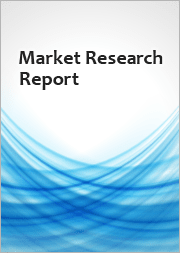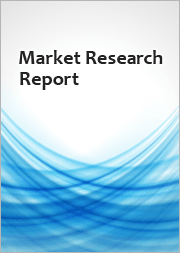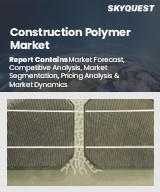
|
시장보고서
상품코드
1675369
특수 폴리머(스페셜티 폴리머) 시장 : 제품 유형별, 최종 용도 산업별, 지역별(2025-2033년)Specialty Polymers Market Report by Product Type, End Use Industry, and Region 2025-2033 |
||||||
세계의 특수 폴리머(스페셜티 폴리머) 시장 규모는 2024년에 870억 달러에 달했습니다. 향후 IMARC Group은 2033년에 1,507억 달러에 달하며, 2025-2033년의 성장률(CAGR)은 5.98%에 달할 것으로 예측하고 있습니다. 자동차 수요의 증가, 일렉트로닉스 분야에서 제품 사용의 증가, 고성능 재료에 대한 요구의 증가, 포장 용도의 확대, 재생에너지 분야에서의 폭넓은 채택 등이 시장 성장 한 요인의 일부입니다.
특수 폴리머는 다양한 산업 및 상업적 용도로 특정 특성이나 기능을 갖도록 설계 및 가공된 합성 소재의 일종입니다. 이러한 폴리머는 일반적으로 기본 폴리머의 화학 구조를 변경하거나 두 가지 이상의 서로 다른 폴리머를 혼합하여 제조됩니다. 특수 폴리머는 고강도, 내구성, 내화학성, 열 안정성, 전도성 등 다양한 고유한 특성을 나타낼 수 있습니다. 일반적으로 사용되는 특수 폴리머에는 열가소성 엘라스토머(TPE), 불소 수지, 액정 폴리머(LCP), 고성능 폴리아미드(HPA), 폴리에테르에테르케톤(PEEK) 등이 있습니다. 최근에는 기존 폴리머가 성능이나 가공 측면에서 한계가 있으며, 적합하지 않은 많은 용도에 이들 재료가 사용되면서 특수 폴리머에 대한 수요가 급증하고 있습니다.
특수 폴리머 시장 동향 :
시장을 촉진하는 주요 요인 중 하나는 자동차, 항공우주, 전자, 의료, 소비재 등의 최종 용도 산업에서 수요가 증가하고 있다는 점입니다. 또한 전기자동차 및 하이브리드차에 대한 수요 증가는 고성능, 경량화 부품의 제조에 특수 폴리머가 사용됨에 따라 시장 전망을 밝게 하고 있습니다. 이 외에도 풍력발전 및 태양광발전과 같은 재생에너지에 대한 수요가 증가함에 따라 특수 폴리머는 풍력 터빈 및 태양전지판용 가볍고 내구성이 뛰어난 부품 제조에 널리 사용되고 있습니다. 또한 특수 폴리머는 우수한 기계적 특성으로 인해 3D 프린팅에도 적용되고 있으며, 이는 복잡하고 고성능의 3D 프린팅 부품 제조에 필수적입니다. 이에 따라 환경 친화적이고 지속가능한 재료에 대한 수요가 생분해성 특수 폴리머의 채택을 촉진하여 생체 적합성 및 고성능 재료 제조에 사용됩니다. 또한 수많은 기술 발전으로 독특한 특성과 용도를 가진 새롭고 혁신적인 특수 폴리머가 탄생하고 있습니다. 기타 성장 촉진요인으로는 각국 정부의 엄격한 규제, 주요 기업의 연구개발 활동, 신흥 경제국의 산업화 및 인프라 구축의 진전 등을 들 수 있습니다.
이 보고서에서 다룬 주요 질문
- 세계 특수 폴리머 시장은 지금까지 어떻게 추이해 왔는가?
- 세계 특수 폴리머 시장의 성장 촉진요인, 억제요인 및 기회는?
- 각 촉진요인, 억제요인 및 기회가 세계 특수 폴리머 시장에 미치는 영향은?
- 주요 지역 시장은?
- 가장 매력적인 특수 폴리머 시장은 어느 국가인가?
- 제품 유형별 시장 분석은?
- 특수 폴리머 시장에서 가장 매력적인 제품 유형은?
- 최종 사용 산업별 시장 분석은?
- 특수 폴리머 시장에서 가장 매력적인 최종 용도 산업은?
- 세계 특수 폴리머 시장의 경쟁 구도는?
- 세계 특수 폴리머 시장의 주요 기업은?
목차
제1장 서문
제2장 조사 범위와 조사 방법
- 조사의 목적
- 이해관계자
- 데이터 소스
- 1차 정보
- 2차 정보
- 시장 추정
- 보텀업 어프로치
- 톱다운 어프로치
- 조사 방법
제3장 개요
제4장 서론
- 개요
- 주요 업계 동향
제5장 세계의 특수 폴리머 시장
- 시장 개요
- 시장 실적
- COVID-19의 영향
- 시장 예측
제6장 시장 내역 : 제품 유형별
- 특수 엘라스토머
- 주요 부문
- 플루오로엘라스토머
- 플루오로실리콘 고무
- 액상 실리콘 고무
- 천연 고무
- 기타
- 주요 부문
- 특수 복합재료
- 주요 부문
- 입자 강화 복합재료
- 섬유 강화 복합재료
- 구조용 복합재료
- 주요 부문
- 특수 열가소성 플라스틱
- 주요 부문
- 폴리올레핀
- 폴리이미드
- 비닐 폴리머
- 폴리페놀
- 기타
- 주요 부문
- 특수 열경화성 수지
- 주요 부문
- 에폭시
- 폴리에스테르
- 비닐에스테르
- 폴리이미드
- 기타
- 주요 부문
- 기타
제7장 시장 내역 : 최종 용도 산업별
- 자동차·운송
- 소비재
- 건축·건설
- 코팅, 접착제, 실란트
- 전기·전자
- 헬스케어
- 기타
제8장 시장 내역 : 지역별
- 북미
- 미국
- 캐나다
- 아시아태평양
- 중국
- 일본
- 인도
- 한국
- 호주
- 인도네시아
- 기타
- 유럽
- 독일
- 프랑스
- 영국
- 이탈리아
- 스페인
- 러시아
- 기타
- 라틴아메리카
- 브라질
- 멕시코
- 기타
- 중동 및 아프리카
- 시장 내역 : 국가별
제9장 촉진요인·억제요인·기회
- 개요
- 촉진요인
- 억제요인
- 기회
제10장 밸류체인 분석
제11장 Porter's Five Forces 분석
- 개요
- 바이어의 교섭력
- 공급 기업의 교섭력
- 경쟁의 정도
- 신규 진출업체의 위협
- 대체품의 위협
제12장 가격 분석
제13장 경쟁 구도
- 시장 구조
- 주요 기업
- 주요 기업의 개요
- 3M Company
- A. Schulman Inc.(LyondellBasell Industries N.V.)
- Arkema S.A.
- Ashland Inc.
- Avient Corporation
- BASF SE
- Croda International Plc
- Dow Inc.
- Evonik Industries AG
- Koninklijke DSM N.V.
- Solvay S.A.
- Specialty Polymers Inc.(The Sherwin-Williams Company)
The global specialty polymers market size reached USD 87.0 Billion in 2024. Looking forward, IMARC Group expects the market to reach USD 150.7 Billion by 2033, exhibiting a growth rate (CAGR) of 5.98% during 2025-2033. The rising automotive demand, increased product use in electronics, emerging need for high-performance materials, elevated packaging applications, and broad adoption in the renewable energy sector are some of the factors contributing to the market growth.
Specialty polymers refer to a class of synthetic materials that have been designed and engineered to possess specific properties and functions for a wide range of industrial and commercial applications. These polymers are typically produced by modifying the chemical structure of the base polymer or by blending two or more different polymers to achieve the desired properties. Specialty polymers can exhibit a range of unique characteristics such as high strength, durability, chemical resistance, thermal stability, and electrical conductivity. Some commonly used specialty polymers include thermoplastic elastomers (TPEs), fluoropolymers, liquid crystal polymers (LCPs), high-performance polyamides (HPAs), and polyetheretherketones (PEEKs). Nowadays, the demand for specialty polymers has escalated as these materials are used in numerous applications where traditional polymers are not suitable due to their limitations in terms of performance or processing.
Specialty Polymers Market Trends:
One of the primary factors driving the market is the growing demand from end-use industries, such as automotive, aerospace, electronics, medical, and consumer goods. Additionally, the increasing demand for electric and hybrid vehicles is creating a positive market outlook, as specialty polymers are used to produce high-performance, lightweight components. Other than this, with the growing need for renewable energy sources, such as wind and solar power, specialty polymers are widely used in the production of lightweight and durable components for wind turbines and solar panels. Besides this, specialty polymers find application in 3D printing as they offer superior mechanical properties, which are essential in producing complex and high-performance 3D printed components. In line with this, the demand for eco-friendly and sustainable materials is driving the adoption of biodegradable specialty polymers used in manufacturing biocompatible and high-performance materials. Furthermore, numerous technological advancements are leading to new and innovative specialty polymers with unique properties and applications. Other growth-inducing factors include stringent regulations implemented by numerous governments of various nations, increasing focus on research and development (R&D) activities by key players, and growth of emerging economies on account of their growing industrialization and infrastructure development.
Key Market Segmentation:
Product Type Insights:
- Specialty Elastomers
- Fluoroelastomers
- Fluorosilicone Rubber
- Liquid Silicone Rubber
- Natural Rubber
- Others
- Specialty Composites
- Particle Reinforced Composites
- Fiber Reinforced Composites
- Structural Composites
- Specialty Thermoplastics
- Polyolefins
- Polyimides
- Vinyl Polymer
- Polyphenols
- Others
- Specialty Thermosets
- Epoxy
- Polyester
- Vinyl Ester
- Polyimides
- Others
- Others
End Use Industry Insights:
- Automotive and Transportation
- Consumer Goods
- Building and Construction
- Coatings, Adhesives, and Sealants
- Electrical and Electronics
- Healthcare
- Others
Regional Insights:
- North America
- United States
- Canada
- Asia-Pacific
- China
- Japan
- India
- South Korea
- Australia
- Indonesia
- Others
- Europe
- Germany
- France
- United Kingdom
- Italy
- Spain
- Russia
- Others
- Latin America
- Brazil
- Mexico
- Others
- Middle East and Africa
- The report has also provided a comprehensive analysis of all the major regional markets, which include North America (the United States and Canada); Europe (Germany, France, the United Kingdom, Italy, Spain, and others); Asia Pacific (China, Japan, India, South Korea, Australia, Indonesia, Russia and others); Latin America (Brazil, Mexico, and others); and the Middle East and Africa. According to the report, Asia Pacific was the largest market for specialty polymers. Some of the factors driving the Asia Pacific specialty polymers market included growing product demand from end-use industries, expanding disposable income levels, and rapid urbanization.
Competitive Landscape:
- The report has also provided a comprehensive analysis of the competitive landscape in the specialty polymers market. Competitive analysis such as market structure, market share by key players, player positioning, top winning strategies, competitive dashboard, and company evaluation quadrant has been covered in the report. Also, detailed profiles of all major companies have been provided. Some of the companies covered include 3M Company, A. Schulman Inc. (LyondellBasell Industries N.V.), Arkema S.A., Ashland Inc., Avient Corporation, BASF SE, Croda International Plc, Dow Inc., Evonik Industries AG, Koninklijke DSM N.V., Solvay S.A., Specialty Polymers Inc. (The Sherwin-Williams Company), etc.
Key Questions Answered in This Report:
- How has the global specialty polymers market performed so far, and how will it perform in the coming years ?
- What are the drivers, restraints, and opportunities in the global specialty polymers market ?
- What is the impact of each driver, restraint, and opportunity on the global specialty polymers market ?
- What are the key regional markets ?
- Which countries represent the most attractive specialty polymers market ?
- What is the breakup of the market based on the product type ?
- Which is the most attractive product type in the specialty polymers market ?
- What is the breakup of the market based on the end use industry ?
- Which is the most attractive end use industry in the specialty polymers market ?
- What is the competitive structure of the global specialty polymers market ?
- Who are the key players/companies in the global specialty polymers market ?
Table of Contents
1 Preface
2 Scope and Methodology
- 2.1 Objectives of the Study
- 2.2 Stakeholders
- 2.3 Data Sources
- 2.3.1 Primary Sources
- 2.3.2 Secondary Sources
- 2.4 Market Estimation
- 2.4.1 Bottom-Up Approach
- 2.4.2 Top-Down Approach
- 2.5 Forecasting Methodology
3 Executive Summary
4 Introduction
- 4.1 Overview
- 4.2 Key Industry Trends
5 Global Specialty Polymers Market
- 5.1 Market Overview
- 5.2 Market Performance
- 5.3 Impact of COVID-19
- 5.4 Market Forecast
6 Market Breakup by Product Type
- 6.1 Specialty Elastomers
- 6.1.1 Market Trends
- 6.1.2 Key Segments
- 6.1.2.1 Fluoroelastomers
- 6.1.2.2 Fluorosilicone Rubber
- 6.1.2.3 Liquid Silicone Rubber
- 6.1.2.4 Natural Rubber
- 6.1.2.5 Others
- 6.1.3 Market Forecast
- 6.2 Specialty Composites
- 6.2.1 Market Trends
- 6.2.2 Key Segments
- 6.2.2.1 Particle Reinforced Composites
- 6.2.2.2 Fiber Reinforced Composites
- 6.2.2.3 Structural Composites
- 6.2.3 Market Forecast
- 6.3 Specialty Thermoplastics
- 6.3.1 Market Trends
- 6.3.2 Key Segments
- 6.3.2.1 Polyolefins
- 6.3.2.2 Polyimides
- 6.3.2.3 Vinyl Polymer
- 6.3.2.4 Polyphenols
- 6.3.2.5 Others
- 6.3.3 Market Forecast
- 6.4 Specialty Thermosets
- 6.4.1 Market Trends
- 6.4.2 Key Segments
- 6.4.2.1 Epoxy
- 6.4.2.2 Polyester
- 6.4.2.3 Vinyl Ester
- 6.4.2.4 Polyimides
- 6.4.2.5 Others
- 6.4.2 Market Forecast
- 6.5 Others
- 6.5.1 Market Trends
- 6.5.2 Market Forecast
7 Market Breakup by End Use Industry
- 7.1 Automotive and Transportation
- 7.1.1 Market Trends
- 7.1.2 Market Forecast
- 7.2 Consumer Goods
- 7.2.1 Market Trends
- 7.2.2 Market Forecast
- 7.3 Building and Construction
- 7.3.1 Market Trends
- 7.3.2 Market Forecast
- 7.4 Coatings, Adhesives and Sealants
- 7.4.1 Market Trends
- 7.4.2 Market Forecast
- 7.5 Electrical and Electronics
- 7.5.1 Market Trends
- 7.5.2 Market Forecast
- 7.6 Healthcare
- 7.6.1 Market Trends
- 7.6.2 Market Forecast
- 7.7 Others
- 7.7.1 Market Trends
- 7.7.2 Market Forecast
8 Market Breakup by Region
- 8.1 North America
- 8.1.1 United States
- 8.1.1.1 Market Trends
- 8.1.1.2 Market Forecast
- 8.1.2 Canada
- 8.1.2.1 Market Trends
- 8.1.2.2 Market Forecast
- 8.1.1 United States
- 8.2 Asia-Pacific
- 8.2.1 China
- 8.2.1.1 Market Trends
- 8.2.1.2 Market Forecast
- 8.2.2 Japan
- 8.2.2.1 Market Trends
- 8.2.2.2 Market Forecast
- 8.2.3 India
- 8.2.3.1 Market Trends
- 8.2.3.2 Market Forecast
- 8.2.4 South Korea
- 8.2.4.1 Market Trends
- 8.2.4.2 Market Forecast
- 8.2.5 Australia
- 8.2.5.1 Market Trends
- 8.2.5.2 Market Forecast
- 8.2.6 Indonesia
- 8.2.6.1 Market Trends
- 8.2.6.2 Market Forecast
- 8.2.7 Others
- 8.2.7.1 Market Trends
- 8.2.7.2 Market Forecast
- 8.2.1 China
- 8.3 Europe
- 8.3.1 Germany
- 8.3.1.1 Market Trends
- 8.3.1.2 Market Forecast
- 8.3.2 France
- 8.3.2.1 Market Trends
- 8.3.2.2 Market Forecast
- 8.3.3 United Kingdom
- 8.3.3.1 Market Trends
- 8.3.3.2 Market Forecast
- 8.3.4 Italy
- 8.3.4.1 Market Trends
- 8.3.4.2 Market Forecast
- 8.3.5 Spain
- 8.3.5.1 Market Trends
- 8.3.5.2 Market Forecast
- 8.3.6 Russia
- 8.3.6.1 Market Trends
- 8.3.6.2 Market Forecast
- 8.3.7 Others
- 8.3.7.1 Market Trends
- 8.3.7.2 Market Forecast
- 8.3.1 Germany
- 8.4 Latin America
- 8.4.1 Brazil
- 8.4.1.1 Market Trends
- 8.4.1.2 Market Forecast
- 8.4.2 Mexico
- 8.4.2.1 Market Trends
- 8.4.2.2 Market Forecast
- 8.4.3 Others
- 8.4.3.1 Market Trends
- 8.4.3.2 Market Forecast
- 8.4.1 Brazil
- 8.5 Middle East and Africa
- 8.5.1 Market Trends
- 8.5.2 Market Breakup by Country
- 8.5.3 Market Forecast
9 Drivers, Restraints, and Opportunities
- 9.1 Overview
- 9.2 Drivers
- 9.3 Restraints
- 9.4 Opportunities
10 Value Chain Analysis
11 Porters Five Forces Analysis
- 11.1 Overview
- 11.2 Bargaining Power of Buyers
- 11.3 Bargaining Power of Suppliers
- 11.4 Degree of Competition
- 11.5 Threat of New Entrants
- 11.6 Threat of Substitutes
12 Price Analysis
13 Competitive Landscape
- 13.1 Market Structure
- 13.2 Key Players
- 13.3 Profiles of Key Players
- 13.3.1 3M Company
- 13.3.1.1 Company Overview
- 13.3.1.2 Product Portfolio
- 13.3.1.3 Financials
- 13.3.1.4 SWOT Analysis
- 13.3.2 A. Schulman Inc. (LyondellBasell Industries N.V.)
- 13.3.2.1 Company Overview
- 13.3.2.2 Product Portfolio
- 13.3.3 Arkema S.A.
- 13.3.3.1 Company Overview
- 13.3.3.2 Product Portfolio
- 13.3.3.3 Financials
- 13.3.3.4 SWOT Analysis
- 13.3.4 Ashland Inc.
- 13.3.4.1 Company Overview
- 13.3.4.2 Product Portfolio
- 13.3.4.3 Financials
- 13.3.4.4 SWOT Analysis
- 13.3.5 Avient Corporation
- 13.3.5.1 Company Overview
- 13.3.5.2 Product Portfolio
- 13.3.5.3 Financials
- 13.3.5.4 SWOT Analysis
- 13.3.6 BASF SE
- 13.3.6.1 Company Overview
- 13.3.6.2 Product Portfolio
- 13.3.6.3 Financials
- 13.3.6.4 SWOT Analysis
- 13.3.7 Croda International Plc
- 13.3.7.1 Company Overview
- 13.3.7.2 Product Portfolio
- 13.3.7.3 Financials
- 13.3.7.4 SWOT Analysis
- 13.3.8 Dow Inc.
- 13.3.8.1 Company Overview
- 13.3.8.2 Product Portfolio
- 13.3.8.3 Financials
- 13.3.8.4 SWOT Analysis
- 13.3.9 Evonik Industries AG
- 13.3.9.1 Company Overview
- 13.3.9.2 Product Portfolio
- 13.3.9.3 Financials
- 13.3.9.4 SWOT Analysis
- 13.3.10 Koninklijke DSM N.V.
- 13.3.10.1 Company Overview
- 13.3.10.2 Product Portfolio
- 13.3.10.3 Financials
- 13.3.10.4 SWOT Analysis
- 13.3.11 Solvay S.A.
- 13.3.11.1 Company Overview
- 13.3.11.2 Product Portfolio
- 13.3.11.3 Financials
- 13.3.11.4 SWOT Analysis
- 13.3.12 Specialty Polymers Inc. (The Sherwin-Williams Company)
- 13.3.12.1 Company Overview
- 13.3.12.2 Product Portfolio
- 13.3.1 3M Company
Kindly note that this only represents a partial list of companies, and the complete list has been provided in the report.



















